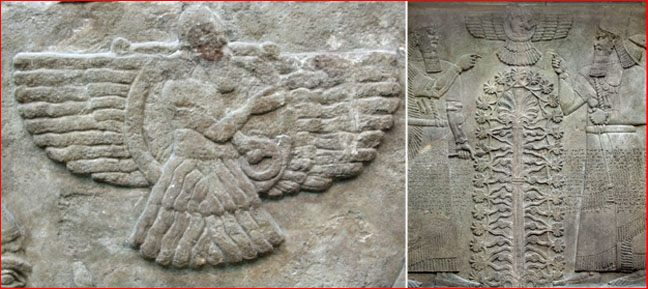


May 19, 2005
The Winged Disk
Hardly any emblem from ancient Near-Eastern art and architecture is more widely known than the winged disc. The winged disc is essentially a circle to which two outstretched wings are attached. It is a religious symbol representing a deity the ancients regarded as the supreme god of the sky. The symbol is found in Egypt, Mesopotamia, Anatolia, and northern Syria and comes in a number of local variations; the Egyptians often attached two coiling uraeus-serpents to its sides or placed two little horns on top of the disc, whereas the Assyrians typically portrayed the disc as a ring containing the upper part of the god in human form. The example shown above on the left corner is a close-up of a panel from the ruins of the 'North West Palace' in Nimrud, northern Iraq, dated to 865-860 BCE.
Why exactly was this deity represented as a winged disc? The short answer is that this particular god was envisioned as a giant bird. Egyptologists have long acknowledged that the Egyptian form of the image could represent Horus the falcon or hawk god. Most specialists would also concur that the winged disc signified some astral god, whose presence in the heavens was symbolized by the flight of a bird. In Egypt, the winged disc was certainly regarded as a symbol of the sun in the first millennium BCE, but there are indications that the myth of this 'sun god' had not originally been based on the behavior of the sun. The archaic sun god of the earlier strata of myth appears to have been some other sun-like object observed in the sky that had afterwards vanished.
There are a number of ways to substantiate this extraordinary claim. One of these is the following: The iconography and the textual evidence reveal that the disc tended to be placed atop some tall landmark, such as a pillar, a gateway, or a tree. The example shown here at the right is a scene from the same palace complex in Nimrud, in which the disc hovers above the so-called tree of life. Scores of Sumerian hymns combine the image of the tree with that of the light of the sun and moon to extol the splendor of the sacred temple buildings. What this means is that the 'tree of life' was seen as a luminous object bright enough to rival the light of the sun. There are no indications that the winged disc was ever thought to abandon its perch on the top of its tree or pillar or to land on it. On the contrary, Mesopotamian texts praise the bird as a form of the tree itself. This 'sun god' seems to have been a stationary deity, fixed above the sacred column until its fateful disruption. Thus, the winged disc fits into the worldwide archetype of the 'bird on top of the tree or pillar', which is reflected as far afield as the north-Pacific coast of North-America, where most totem poles carry the image of Raven with his outstretched wings on top.
The peculiar morphology of the winged disc receives a straightforward explanation in the interdisciplinary method of 'plasma mythology', as advocated on these pages. Extensive laboratory experiments and a worldwide survey of petroglyphs have led plasma physicist Anthony Peratt to conclude that the past has witnessed the formation of a heaven-reaching plasma discharge tube, precipitated by a large influx of charged particles from space and an increased solar wind. The detailed reconstruction of the development of this column offers a strikingly close match to the archetypal aspects attributed to the 'cosmic tree' in ancient traditions around the globe. A shock pulse exercised on the circumpolar regions of the earth would have produced a plasma instability resulting in just such extensions to the column as the 'wings' of the disc at the top. The spiky features of these plasma discharge “wings” strongly resemble flaming feathers. In origin, then, it might be that the winged disc commemorated something far stranger than the ordinary sun: a 'primordial sun' whose wings answered not to fancy, but to astronomical reality.
To explore this line of reasoning will require close attention to the archetypes, or primary symbolic themes repeated around the world. It is now clear that a coherent underlying layer of world mythology and symbolism can be identified through cross-cultural comparison. The convergence of comparative mythology and plasma science could forever alter our perspective on the human past
See Also:
Jan 03, 2005 In the Coils of the Serpent
Jan 14, 2005 The Vortical Tree
May 13, 2005 The Feathered Serpent
Contributed by Rens van der Sluijs